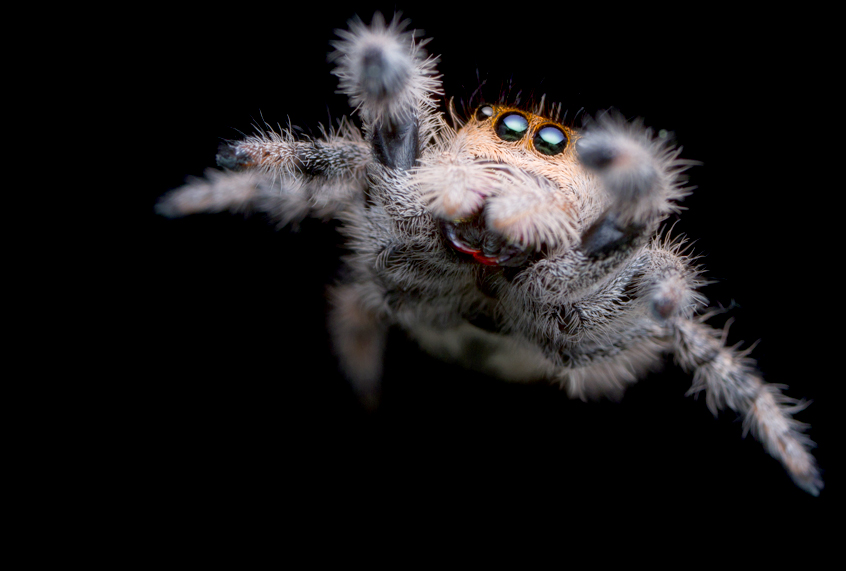It’s early in the morning. The buzzer goes off, you switch on the light and immediately panic: a large spider sits on your bedroom wall!
Many people suffer from arachnophobia, which is the fear of spiders. Their arachnophobic responses range from subtle discomfort to fumigating their homes. Yet, they have no reasons to be afraid of spiders. They just don’t know them well enough. Luckily, fact-based education of arachnophobes helps alleviate their extreme and irrational fear of spiders and enables them to live a less stressful and fearful life.
Education about spiders dispels fear, avoids misconceptions and instils a sense of appreciation and wonder. Spiders are among the most fascinating and diverse creatures on Earth.
The roots of arachnophobia
No one knows the origin of this widespread arachnophobia. With respect to evolution, this phenomenon does not make immediate sense. Avoidance behaviour to a perceived threat might have evolved if that threat were to be persistent. But spiders do not pose such persistent threats to humans. This is puzzling to scientists.
There are only a few spiders that could possibly harm us. Most spiders are physically not even able to cause any harm. They are unable to puncture our skin or their venom does not irritate our body tissue.
In Canada, black widow spiders have neurotoxins and can pierce through our skin but they are not really dangerous to healthy adults (though children and elderly would need to be watched). Black widows are not aggressive. For them to bite a person, you have to virtually squeeze them. The non-aggressiveness of most spiders, even the venomous ones, effectively renders them harmless.
Ill-reputed spiders
Fake news about spiders dominate folklore and spread through internet. For example, the bites of brown recluse spiders can cause necrosis, but it is their harmless cousins, the hobo spiders, that live in Canada. Similarly, false black widows — who look like black widows but are harmless — often find their way into our homes, but are less likely to bite us than bees are to sting us when they accidentally fly into our homes.
Unfortunately, many alleged spider bites are misdiagnosed, and the bite symptoms were actually inflicted by other critters or microbes. Such misdiagnoses may even become health-threatening when they prompt inappropriate treatment(s) of the patient. For this reason alone, it is always helpful to capture the alleged biter so that it can be identified, and the patient be treated accordingly.
When encountering a spider at home, many people opt for spraying it with pesticide. But pesticides have long-lasting residual activity, adversely affecting us, our children and pets. Strategically-placed sticky traps (e.g. behind appliances) are a safe alternative to remove spiders and other unwanted creepy crawlies from our homes.
Spiders’ place in the ecosystems
By capturing countless insects, spiders play key roles in ecosystems and in agricultural and forestry settings. It is the friendly neighbourhood spider that helps protect our crops from insect herbivores. Once we open our eyes to the world of spiders, we will be amazed instead of disgusted and be fascinated instead of fearful. A few stories may serve as examples.
Males of the nursery web spider offer bridal gifts to their future mates. While the female is enjoying her snack, he strives to mate with her before she finishes eating and before she wants him for “dessert”.
The phenomenal jumping ability when they pounce on prey “inspidered” the moniker jumping spiders and is only one reason why they are so fascinating. Entertainingly colourful, extremely photogenic, but no bigger than a thumbnail, the males of some jumping spiders put on a dance-off with remarkable moves to impress females. Jumping spiders use hydraulic pressure to extend their legs, and from standstill can leap distances up to six times their body length. We humans have to contend with a standstill leaping distance of merely 1.5 times our body length. And just for the record: humans did not invent the hydraulics in our engines, we merely copied the spiders’ invention.
The tiny Darwin’s bark spider is another Guinness record holder. It builds beautiful 25 m wide(!) orb-webs across rivers. Its silk is one of the toughest natural materials known. If we were to weave it into t-shirts, they would be bullet-proof.
Spiders are diverse in shape and behaviour. Some spiders build webs which they never leave, while others walk around to hunt, or dig tunnels within which they await prey passing by. Spiders weave many different types of webs, each serving a specific purpose. Other spiders won’t simply wait for prey, they attract it. Bolas spiders produce the female sex pheromone of some moths. This pheromone then attracts male moths that fly towards the spider in anticipation to find a moth mate. When the female spider hears the male moth approaching, she swings her sticky bola and snares him out of the air. The mosquito-terminator spider, on the other hand, spares no efforts to hunt down mosquitoes that have recently fed on blood.
Spiders may be more afraid of us than we are of them: they are not aggressive and would rather be left alone. If we consider the many things we can learn about and from spiders, our fear of spiders will turn into fascination for spiders.
Gerhard J. Gries, Professor & NSERC-Industrial Research Chair in Multimodal Animal Comminication Ecology, Simon Fraser University and Andreas Fischer, PhD student, Simon Fraser University
This article is republished from The Conversation under a Creative Commons license. Read the original article.

